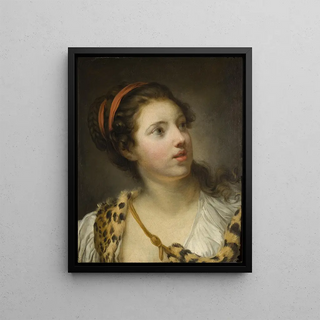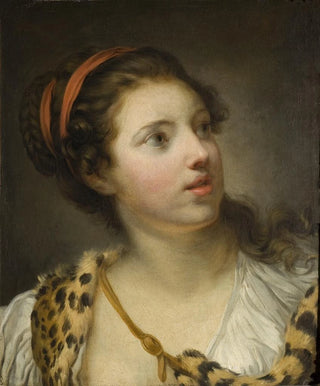Art print | Callisto the Nymph - Jean-Baptiste Greuze


View from behind

Frame (optional)
In the fascinating world of art, certain works stand out for their ability to capture the very essence of human emotion. "The Nymph Callisto" by Jean-Baptiste Greuze is one of those creations that transcend time. Created in the 18th century, this painting evokes delicate beauty and psychological depth that invite the viewer to delve into a rich and complex mythological story. Callisto, a nymph of the goddess Diana, is depicted here in a moment of vulnerability and contemplation, embodying the duality of beauty and tragedy. This piece, far more than a simple representation, is an invitation to explore themes of love, loss, and human nature.
Style and uniqueness of the work
Greuze's style is characterized by an intimate approach and meticulous attention to detail. In "The Nymph Callisto," the artist uses subtle lighting to accentuate the delicate features of the nymph's face, creating an atmosphere imbued with melancholy. Soft colors and refined textures demonstrate exceptional technical mastery, allowing the work to breathe a certain lightness while conveying deep emotions. Greuze excels in depicting feelings, and here, Callisto's slightly turned posture seems to capture a fleeting thought, an introspection that resonates with anyone who has experienced the uncertainty of love. The composition itself, with its harmonious balance, guides the viewer's gaze toward the nymph's face, making this piece a true masterpiece of expression.
The artist and his influence
Jean-Baptiste Greuze, an emblematic figure of the Rococo movement, established himself as a master of narrative painting. His ability to tell stories through his portraits and genre scenes marked his era and continues to influence many contemporary artists. Greuze, inspired by moral values and human emotions, created a bridge between art and everyday life. His work "The Nymph Callisto" reflects his interest in mythological stories, while highlighting feminine sensitivity.

Matte finish

View from behind

Frame (optional)
In the fascinating world of art, certain works stand out for their ability to capture the very essence of human emotion. "The Nymph Callisto" by Jean-Baptiste Greuze is one of those creations that transcend time. Created in the 18th century, this painting evokes delicate beauty and psychological depth that invite the viewer to delve into a rich and complex mythological story. Callisto, a nymph of the goddess Diana, is depicted here in a moment of vulnerability and contemplation, embodying the duality of beauty and tragedy. This piece, far more than a simple representation, is an invitation to explore themes of love, loss, and human nature.
Style and uniqueness of the work
Greuze's style is characterized by an intimate approach and meticulous attention to detail. In "The Nymph Callisto," the artist uses subtle lighting to accentuate the delicate features of the nymph's face, creating an atmosphere imbued with melancholy. Soft colors and refined textures demonstrate exceptional technical mastery, allowing the work to breathe a certain lightness while conveying deep emotions. Greuze excels in depicting feelings, and here, Callisto's slightly turned posture seems to capture a fleeting thought, an introspection that resonates with anyone who has experienced the uncertainty of love. The composition itself, with its harmonious balance, guides the viewer's gaze toward the nymph's face, making this piece a true masterpiece of expression.
The artist and his influence
Jean-Baptiste Greuze, an emblematic figure of the Rococo movement, established himself as a master of narrative painting. His ability to tell stories through his portraits and genre scenes marked his era and continues to influence many contemporary artists. Greuze, inspired by moral values and human emotions, created a bridge between art and everyday life. His work "The Nymph Callisto" reflects his interest in mythological stories, while highlighting feminine sensitivity.






